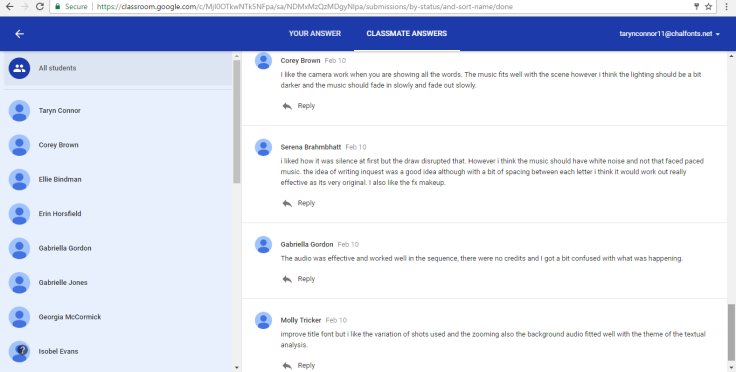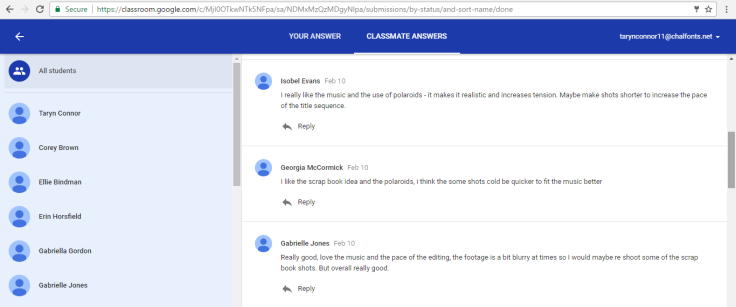In my opinion, our first cut for our media task revealed some strengths and many weaknesses because at this point we are far from being finished.
For instance the ending of the sequence was not complete, including the missing sound of the mother’s voice telling the girl to hurry up. This could be improved for next time by adding in the diegetic sound of the voice-over when the black screen is on screen in the edit at 1:33.
But my group had a discussion afterwards suggesting that we shouldn’t include this voice-over because it may take away the suspense and so we thought of having extreme close up shots of the girl’s phone with messages appearing onscreen.
On the other hand, I find the constant back and forth (called montage editing technique) displaying the making of the craft book, to her pinning items on the board effective because it builds tension as the audience are left anticipated to see what is going to happen next. Furthermore, we didn’t want the audience to be able to predict what was going to occur, so having this montage edit makes it difficult for them to do so, whilst leaving them intrigued to know more; a common convention of the thriller genre.
However, as we hadn’t finished filming completely we lacked in the amount of footage that would enable us to achieve the result of montage editing in a fast manner that would create and build suspense throughout the sequence; working well with the fast paced background music.
Moreover, we revealed our unfinished rough cut to our class in order to gain their interpretations to our sequence and their feedback to our use of camera, editing, mise-en-scene and sound; within each of their responses they included their beliefs on our strengths as well as possible improvements.
This was all in the form of SIR (strengths and improvements) on Google Classroom, see below for evidence of this:



Our audience’s feedback on our strengths:
- The majority of comments described how they enjoyed the idea/story of having the Polaroid pictures with our group’s faces on it (the credits would be on this), and having the ending of the name “INQUEST” for our thriller opening credits spelt out in the red string.
- They also picked up on the variety of camera angles, shots, movement and zooming techniques used; which suggests that camerawork was a strong aspect in our sequence.
- Many comments described how the audio fitted well with what was being displayed on screen as the strident sounds of the instruments created a tense atmosphere, reflective of how they felt when watching the sequence.
Elements we need to improve from their comments include:
- Some noticing that although the silence at the beginning created an eerie effect, this was disrupted by the diegetic sound of the draw being opened, followed by a sudden transition to background music. This meant that they thought we could adjust the harshness of the sound by having it fading in and out at the beginning/end or instead someone suggested having ambient sounds like white noise playing throughout. But this leaves it up for our group to chose between these two possible ideas implied from our audience’s feedback.
- The quality of the footage was “blurry” and “shaky” at times according to the comments, which means that we have to film again to improve this; especially during the camera zoom on the Polaroid pictures as it wasn’t intentional to be shaky, we just couldn’t manage it, as the tripod’s legs would’ve been seen in the shot, so we had to use the camera hand-held.
- Also, some had implied that using darker lighting (low-key lighting) would result in the sequence being seen more as a thriller for this very reason. Therefore, we will go back to our idea of having the lighting dark, enabling more distinct shadows to be seen in the sequence, like during the final shot of the girl turning to walk away from the board, the use of shadows would contrast against the light background intensifying the end to the sequence.
- There was no use of titles/credits which the audience would have expected to see; as a group we knew we had to include the titles but we didn’t have enough time to edit this in as well as not deciding on a particular font yet. In addition, we had not yet finished filming all of the footage, hence why the duration of some shots were too long as the credit would be on the Polaroid pictures. Therefore, we will have a discussion to talk about a suitable font to use and where it should be positioned in an effective way on screen.
As you can see from these feedback comments, it’s clear that we need to re film to achieve some of these improvements I have discussed in this blog post; which I find the feedback extremely helpful because areas of mistakes in need of improvement was pointed out to us; we would of not noticed ourselves without this form that is helping us to develop our title sequence for a thriller film, on a higher level.

Leave a comment